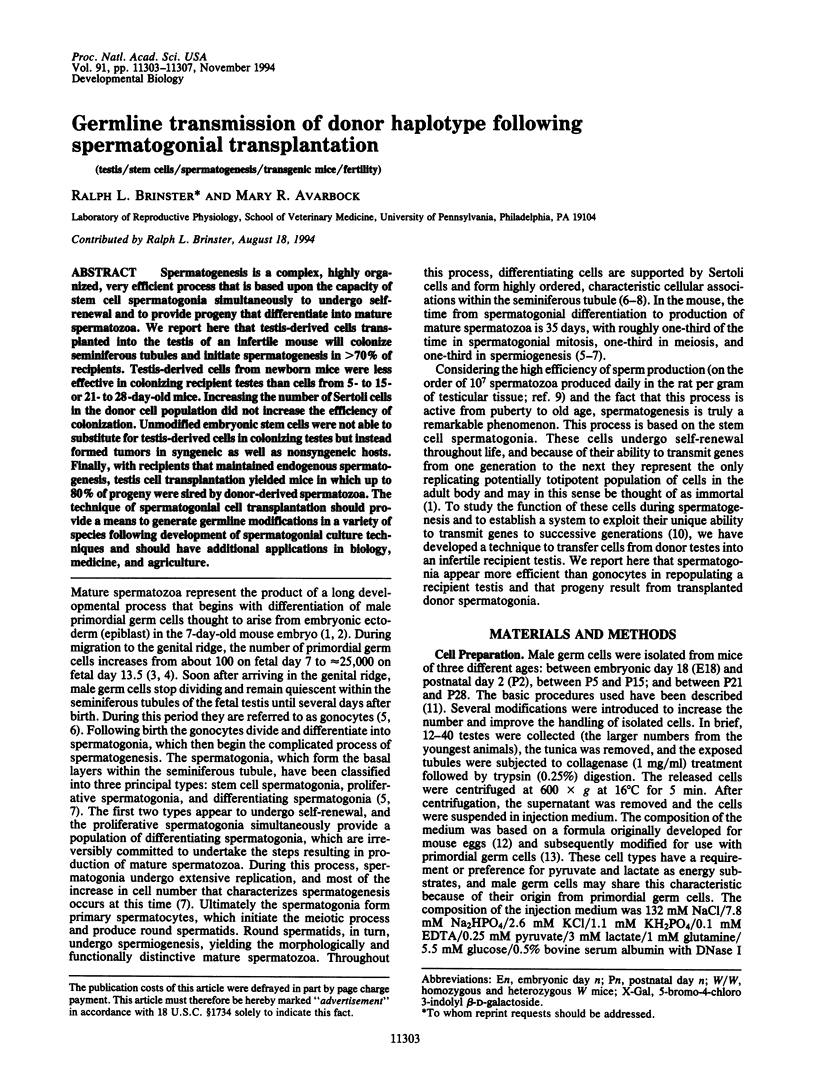Abstract
Spermatogenesis is a complex, highly organized, very efficient process that is based upon the capacity of stem cell spermatogonia simultaneously to undergo self-renewal and to provide progeny that differentiate into mature spermatozoa. We report here that testis-derived cells transplanted into the testis of an infertile mouse will colonize seminiferous tubules and initiate spermatogenesis in > 70% of recipients. Testis-derived cells from newborn mice were less effective in colonizing recipient testes than cells from 5- to 15- or 21- to 28-day-old mice. Increasing the number of Sertoli cells in the donor cell population did not increase the efficiency of colonization. Unmodified embryonic stem cells were not able to substitute for testis-derived cells in colonizing testes but instead formed tumors in syngeneic as well as nonsyngeneic hosts. Finally, with recipients that maintained endogenous spermatogenesis, testis cell transplantation yielded mice in which up to 80% of progeny were sired by donor-derived spermatozoa. The technique of spermatogonial cell transplantation should provide a means to generate germline modifications in a variety of species following development of spermatogonial culture techniques and should have additional applications in biology, medicine, and agriculture.
Full text
PDF




Images in this article
Selected References
These references are in PubMed. This may not be the complete list of references from this article.
- Bellvé A. R., Cavicchia J. C., Millette C. F., O'Brien D. A., Bhatnagar Y. M., Dym M. Spermatogenic cells of the prepuberal mouse. Isolation and morphological characterization. J Cell Biol. 1977 Jul;74(1):68–85. doi: 10.1083/jcb.74.1.68. [DOI] [PMC free article] [PubMed] [Google Scholar]
- Bradley A., Hasty P., Davis A., Ramirez-Solis R. Modifying the mouse: design and desire. Biotechnology (N Y) 1992 May;10(5):534–539. doi: 10.1038/nbt0592-534. [DOI] [PubMed] [Google Scholar]
- Brinster R. L., Harstad H. Energy metabolism in primordial germ cells of the mouse. Exp Cell Res. 1977 Oct 1;109(1):111–117. doi: 10.1016/0014-4827(77)90050-7. [DOI] [PubMed] [Google Scholar]
- Brinster R. L. Stem cells and transgenic mice in the study of development. Int J Dev Biol. 1993 Mar;37(1):89–99. [PubMed] [Google Scholar]
- Bucci L. R., Meistrich M. L. Effects of busulfan on murine spermatogenesis: cytotoxicity, sterility, sperm abnormalities, and dominant lethal mutations. Mutat Res. 1987 Feb;176(2):259–268. doi: 10.1016/0027-5107(87)90057-1. [DOI] [PubMed] [Google Scholar]
- Karl A. F., Griswold M. D. Sertoli cells of the testis: preparation of cell cultures and effects of retinoids. Methods Enzymol. 1990;190:71–75. doi: 10.1016/0076-6879(90)90010-x. [DOI] [PubMed] [Google Scholar]
- MINTZ B., RUSSELL E. S. Gene-induced embryological modifications of primordial germ cells in the mouse. J Exp Zool. 1957 Mar;134(2):207–237. doi: 10.1002/jez.1401340202. [DOI] [PubMed] [Google Scholar]
- Matsui Y., Zsebo K., Hogan B. L. Derivation of pluripotential embryonic stem cells from murine primordial germ cells in culture. Cell. 1992 Sep 4;70(5):841–847. doi: 10.1016/0092-8674(92)90317-6. [DOI] [PubMed] [Google Scholar]
- McLaren A. Embryology. The quest for immortality. Nature. 1992 Oct 8;359(6395):482–483. doi: 10.1038/359482a0. [DOI] [PubMed] [Google Scholar]
- Stewart C. L., Gadi I., Bhatt H. Stem cells from primordial germ cells can reenter the germ line. Dev Biol. 1994 Feb;161(2):626–628. doi: 10.1006/dbio.1994.1058. [DOI] [PubMed] [Google Scholar]
- Tam P. P., Snow M. H. Proliferation and migration of primordial germ cells during compensatory growth in mouse embryos. J Embryol Exp Morphol. 1981 Aug;64:133–147. [PubMed] [Google Scholar]
- Wing T. Y., Christensen A. K. Morphometric studies on rat seminiferous tubules. Am J Anat. 1982 Sep;165(1):13–25. doi: 10.1002/aja.1001650103. [DOI] [PubMed] [Google Scholar]
- Zambrowicz B. P., Zimmermann J. W., Harendza C. J., Simpson E. M., Page D. C., Brinster R. L., Palmiter R. D. Expression of a mouse Zfy-1/lacZ transgene in the somatic cells of the embryonic gonad and germ cells of the adult testis. Development. 1994 Jun;120(6):1549–1559. doi: 10.1242/dev.120.6.1549. [DOI] [PubMed] [Google Scholar]





